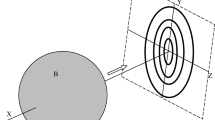Abstract
In two recent papers Perez Laraudogoitia has described a variety of supertasks involving elastic collisions in Newtonian systems containing a denumerably infinite set of particles. He maintains that these various supertasks give examples of systems in which energy is not conserved, particles at rest begin to move spontaneously, particles disappear from a system, and particles are created ex nihilo. An analysis of these supertasks suggests that they involve systems that do not satisfy the mathematical conditions required of Newtonian systems at the time the supertask is due to be completed, or else they rely on the application of the time-reversal transformation to states which are not well-defined. Consequently, it is unjustified to conclude that the paradoxical results are arising from within the framework of Newtonian mechanics. In the last part of this article, we discuss various aspects of the physics of these supertasks.
Similar content being viewed by others
REFERENCES
Alper, J. S. and Bridger, M.: 1997, ‘Mathematics, Models, and Zeno's Paradoxes of Motion’, Synthese 110, 143–166.
Benacerraf, P.: 1970, ‘Tasks, Super-Tasks, and the Modern Eleatics’, in W. C. Salmon (ed.), Zeno's Paradoxes, Bobbs-Merrill, Indianapolis and New York, pp. 103–129.
Davies, P. C. W.: 1977, The Physics of Time Asymmetry, Berkeley, Calif.: University of California Press.
Dieudonné, J.: 1960, Foundations of Modern Analysis, New York: Academic Press.
Feynman, R.: 1963, Lecture on Physics vol 1, Reading, Mass: Addison-Wesley.
Goldstein, H.: 1980, Classical Mechanics, 2nd Ed. Reading, Mass: Addison-Wesley.
Gottfried, K.: 1966, Quantum Mechanics, New York: Benjamin.
Grünbaum, A.: 1968, Modern Science and Zeno's Paradoxes of Motion, in W. C. Salmon (ed.), Zeno's Paradoxes, Bobbs-Merrill, Indianapolis and New York, pp. 200–250.
Hirsch, M. W. and Smale, S.: 1974, Differential Equations, Dynamical Systems, and Linear Algebra, Orlando, Florida: Academic Press.
Kleene, S.: 1950, Introduction to Metamathematics. Princeton, New Jersey: D. van Nostrand.
Misner, C. W., Thorne, K. S., and Wheeler, J. A.: 1973, Gravitation, San Francisco: Freeman.
Omnes, R.: 1994, The Interpretation of Quantum Physics, Princeton, New Jersey: Princeton, University Press.
Perez Laraudogoitia, J.: 1996, ‘A Beautiful Supertask’, Mind 105, 81–83.
Perez Laraudogoitia, J.: 1998, ‘Infinity Machines and Creation Ex Nihilo’, Synthese 114, (this issue).
Riesz, F. and Sz.-Nagy, B.: 1955, Functional Analysis, New York: Unger.
Author information
Authors and Affiliations
Rights and permissions
About this article
Cite this article
Alper, J.S., Bridger, M. Newtonian Supertasks: A Critical Analysis. Synthese 114, 355–369 (1998). https://doi.org/10.1023/A:1005057130067
Issue Date:
DOI: https://doi.org/10.1023/A:1005057130067




